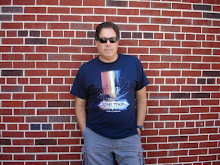Monday, February 11, 2013
JAZZ SINGER, THE (1927)
(October 1927, U.S.)
Just how good would you consider your imagination and appreciation of cinema history to be? I've come to realize over time that I very likely lose the attention of a small portion of my readers whenever I discuss a film that dates back even before their grandparents were born. However, it's impossible to ignore the significance of certain films and their place in history. Therefore, this particular film deserves mention, honor and respect not only from this blog, but from those who claim true film appreciation. For the sake of absolute fact and clarity, THE JAZZ SINGER was the first feature-length motion picture with synchronized dialogue sequences. Its initial release heralded the commercial ascendance of the "talkies" and the inevitable decline of the classic silent film era. Despite this great achievement, it should also be noted that the film only features a specific portion of actual dialogue. Most of the film is still actually silent.
As a kid, I experienced two misconceptions concerning this film. The first was that I thought the rather campy 1980 Neil Diamond version of THE JAZZ SINGER was, in fact, an original film and not a remake (the fourth film version, actually). The second was that I actually thought Al Jolson was a black man because the only pictures I'd ever seen of the man was when he was wearing his infamous blackface makeup. Yes, it looked just that convincing to a kid who didn't know any better. Take a look...
During a time of Hollywood show business that was primarily run by Jewish men who'd come to the United States as immigrants, THE JAZZ SINGER is one of the most Jewish tales I've ever seen on film. It tells the story of young Jakie Rabinowitz blatantly defying the traditions of his devout Jewish family by singing popular jazz tunes in a local beer hall. Punished by his strict father, a neighborhood cantor, Jakie runs away from home in defiance. Some years later, now under the name of Jack Robin, he's become a very talented jazz singer with an eye towards national fame. He slowly builds his career as an entertainer and falls in love with a woman who's not Jewish (a SHIKSA - OY!!), but his professional ambitions ultimately come into conflict with the demands of his home and heritage as his father lies in bed dying from an undisclosed illness and a broken heart over the estranged relationship with his son. Although someone like myself doesn't relate too well to the ancient traditions of Jewish faith and practices, the conflict between personal ambition and loyalties to honor and family are easily appreciated by even a world-class cynic such as I.
In contrast to the inevitable racial jokes and innuendos brought out in its subsequent persistence in early sound film, the blackface imagery in THE JAZZ SINGER is truly at the core of the film's central theme as an artistic and expressive exploration of the notion of ethnic duplicity within the American identity. The meaning and function of the blackface in this film is intimately involved with Jack Robin's own precious Jewish heritage combined with his desire to make his mark in mass American pop culture, much the same as the Jewish man Al Jolson and the Jewish Warner brothers themselves were doing in real life. The film's apparant thesis is that, in order to truly succeed in life, a man such as Jack must first acknowledge his ethnic self and the past traditions that have come to define him. It can be argued, therefore, that the blackface serves as the screen's symbol of Jack's compounded identity issue and manages to hold all the identities together without freezing them in any singular relationship. This sort of philosophy may not hold the same relevance in a world that's become so damn politically correct, but again, you need to reach back into the past with your imagination and consideration for a film that breaks ground on so many levels.
Lastly, using that imagination and appreciation I keep insisting upon, try and envision a premiere of such a film back in the glorious days when movies were still relatively new. By today's standards, of course, this would be an insignificant Friday night opening at the local, impersonal neighborhood multiplex. However, the premiere for THE JAZZ SINGER was set for October 6, 1927, at the Warner Brothers flagship theater in New York City. The specific choice of that date was pure Jewish show business in that the following day was Yom Kippur, the sacred Jewish holiday around which much of the film's plot revolves. Here's what that spectacularly crowded scene looked like...
And so, with the introduction of one film, "talkies" were born and the motion picture industry changed forever. THAT, my friends, impresses me a whole hell of a lot more than the latest bullshit digital 3D effects on any screen!
Favorite line or dialogue:
Jack Robin: "Wait a minute, wait a minute, you ain't heard nothin' yet! Wait a minute I tell ya, you ain't heard nothin'!"
Yes, those words said it all!
Subscribe to:
Post Comments (Atom)





No comments:
Post a Comment